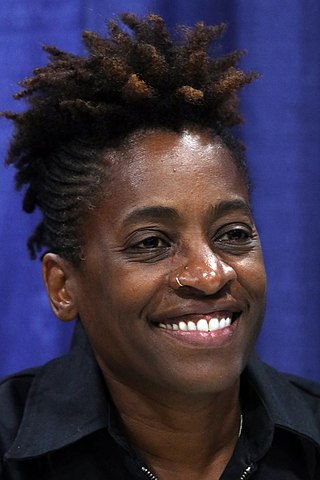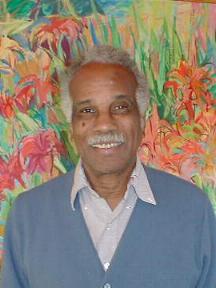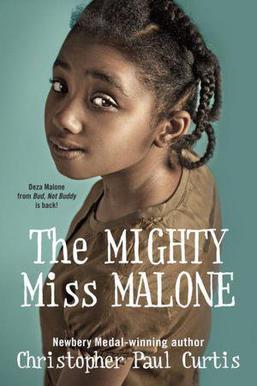The Hopwood Awards are a major scholarship program at the University of Michigan, founded by Avery Hopwood.

Roll of Thunder, Hear My Cry is a 1977 Newbery Medal awarded novel by Mildred D. Taylor. It is a part of her Logan family series, a sequel to her 1975 novella Song of the Trees.

Paul Fleischman is an American writer of children's books. He and his father Sid Fleischman have both won the Newbery Medal from the American Library Association recognizing the year's "most distinguished contribution to American literature for children". For the body of his work he was the United States author nominee for the international Hans Christian Andersen Award in 2012.

Christopher Paul Curtis is an American children's book author. His first novel, The Watsons Go to Birmingham – 1963, was published in 1995 and brought him immediate national recognition, receiving the Coretta Scott King Honor Book Award and the Newbery Honor Book Award in addition to numerous other awards. In 2000, he became the first person to win both the Newbery Medal and the Coretta Scott King Award—prizes received for his second novel Bud, Not Buddy—and the first African-American man to win the Newbery Medal. His novel The Watsons Go to Birmingham – 1963 was made into a television film in 2013.

Virginia Esther Hamilton was an American children's books author. She wrote 41 books, including M. C. Higgins, the Great (1974), for which she won the U.S. National Book Award in category Children's Books and the Newbery Medal in 1975. Her works were celebrated for exploring the African-American experience, what she called "Liberation Literature."
The Coretta Scott King Award is an annual award presented by the Coretta Scott King Book Award Round Table, part of the American Library Association (ALA). Named for Coretta Scott King, wife of Martin Luther King Jr., this award recognizes outstanding books for young adults and children by African Americans that reflect the African American experience. Awards are given both to authors and to illustrators.

Walter Dean Myers was an American writer of children's books best known for young adult literature. He was born in Martinsburg, West Virginia, but was raised in Harlem, New York City. A tough childhood led him to writing and his school teachers would encourage him in this habit as a way to express himself. He wrote more than one hundred books including picture books and nonfiction. He won the Coretta Scott King Award for African-American authors five times. His 1988 novel Fallen Angels is one of the books most frequently challenged in the U.S. because of its adult language and its realistic depiction of the Vietnam War.

The Watsons Go to Birmingham – 1963 is a historical-fiction novel by Christopher Paul Curtis. First published in 1995 by Delacorte Press, it was reprinted in 1997. It tells the story of the Watsons, a lower middle class African-American family living in Flint, Michigan in the early 1960s from the perspective of Kenny Watson, the middle child of three. The first part of the novel focuses on Kenny's struggles to make friends as a smart and thoughtful ten-year-old, then shifts in setting when his parents decide to deliver their oldest son, Byron, to live with his grandmother in Birmingham, Alabama. The family embarks on a road trip to the Deep South, and while visiting Alabama, they get caught up in a tragic historical event of the Civil Rights Movement.

Patricia C. McKissack was a prolific African American children's writer. She was the author of over 100 books, including Dear America books A Picture of Freedom: The Diary of Clotee, a Slave Girl;Color Me Dark: The Diary of Nellie Lee Love, The Great Migration North; and Look to the Hills: The Diary of Lozette Moreau, a French Slave Girl. She also wrote a novel for The Royal Diaries series: Nzingha: Warrior Queen of Matamba. Notable standalone works include Flossie & the Fox (1986), The Dark-Thirty: Southern Tales of the Supernatural (1992), and Sojourner Truth: Ain't I a Woman? (1992). What is Given from the Heart was published posthumously in 2019.

Jacqueline Woodson is an American writer of books for children and adolescents. She is best known for Miracle's Boys, and her Newbery Honor-winning titles Brown Girl Dreaming, After Tupac and D Foster, Feathers, and Show Way. After serving as the Young People's Poet Laureate from 2015 to 2017, she was named the National Ambassador for Young People's Literature, by the Library of Congress, for 2018 to 2019. Her novel Another Brooklyn was shortlisted for the 2016 National Book Award for Fiction. She won the Astrid Lindgren Memorial Award in 2018. She was named a MacArthur Fellow in 2020.

Christopher Myers is an American interdisciplinary artist, author and illustrator of children's books, and playwright. His wide-ranging practice—including tapestries, sculpture, stained glass lightboxes, theater and writing—is rooted in storytelling and artmaking as modes of transformation and cultural exchange. He explores contemporary hybrid cultures and identities resulting from histories of migration, globalization and colonization. Critics have noted his work's fluid movement between disciplines, image and language, sociopolitical research and mythology, and diverse materials. Shana Nys Dambrot of LA Weekly wrote, "Ideas about authorship, collaboration, cross-cultural pollination, intergenerational storytelling, mythology, literature and the oral histories of displaced communities all converge in his literal and metaphorical patchwork tableaux … [his] sharp, emotional and sometimes dark parables express it all in bright, jubilant patterns and saturated colors."

Ashley Frederick Bryan was an American writer and illustrator of children's books. Most of his subjects are from the African-American experience. He was U.S. nominee for the Hans Christian Andersen Award in 2006 and he won the Laura Ingalls Wilder Award for his contribution to American children's literature in 2009. His picture book Freedom Over Me was short-listed for the 2016 Kirkus Prize and received a Newbery Honor.

Eloise Greenfield was an American children's book and biography author and poet famous for her descriptive, rhythmic style and positive portrayal of the African-American experience.

Elijah of Buxton is a 2007 children's novel by Christopher Paul Curtis. The book won critical praise and was a Newbery Honor book and the winner of the Coretta Scott King Award. It also was a children's book bestseller.

The Mighty Miss Malone is a 2012 children's novel by author Christopher Paul Curtis and is a follow-up to his 2000 book Bud, Not Buddy. Wendy Lamb Books released the book on January 10, 2012. The Mighty Miss Malone follows the character of 12-year-old African-American Deza Malone, who narrates the book.
Mildred DeLois Taylor is a Newbery Award-winning American young adult novelist. She is best known for her novel Roll of Thunder, Hear My Cry, part of her Logan family series.

Kwame Alexander is American poet, educator, publisher, Emmy® Award-winning producer, and #1 New York Times bestselling author of 40 books, including poetry, memoir, and children's fiction. His mission is to change the world, one word at a time.

Crown: An Ode to the Fresh Cut is a 2017 picture book by Derrick Barnes, illustrated by Gordon C. James. The book, Barnes' first picture book, is a poem describing a boy's feelings and experience while getting a haircut. James, who was not the first choice to be the illustrator, wanted the oil color illustrations to have the feel of fine art.

Jazz is a 2006 picture book by Walter Dean Myers, illustrated by Christopher Myers. The picture book is a collection of illustrations and rhyming text celebrating the roots of Jazz music.
















